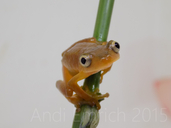|
Opisthothylax immaculatus (Boulenger, 1903)
Gray-eyed Frog | family: Hyperoliidae genus: Opisthothylax |
 © 2016 Greg F.M. Jongsma (1 of 8) |
|
|
|
Description Amiet (1974a) describes the tadpoles of Opisthothylax immaculatus as bearing a resemblance to those of the genus Afrixalus. Opisthothylax immaculatus tadpoles are not large, measuring 25.5 mm in length at the stage just prior to the emergence of hindlimbs. In profile, the body is flattened. The eyes are located dorsolaterally. The snout is rounded, with small nostrils located nearer to the end of the snout than to the eyes. The larval mouth is subterminal (in contrast to Afrixalus tadpoles which have terminal mouths) and small. The beaks are reduced with a scalloped edge and the mouth lacks denticles entirely. The lower lip is subdivided into 10-14 short papillae. The spiracle is medial and sinistral, while the vent is dextral. The tail is a little higher than the body, reaching maximum height at about two-thirds of its length, with a pointed tip. The dorsal surface of the larval body is yellowish-beige with dense light brown spots, especially on the snout, between the eyes, on the sides, and in the middle of the dorsum; this coloring darkens as the tadpole matures. In contrast, the venter is dark, almost black on the anterior half, shading to cream in the middle and clear posteriorly, with the sides being brown. The tail is yellowish with marbled brown. On hatching, two large dark spots are visible, converging at the start of the upper caudal crest. The presence of these two spots appear to constitute a good character for Opisthothylax immaculatus tadpole identification (Amiet 1974a). Distribution and Habitat Country distribution from AmphibiaWeb's database: Cameroon, Congo, the Democratic Republic of the, Equatorial Guinea, Gabon, Nigeria
Life History, Abundance, Activity, and Special Behaviors Opisthothylax immaculatus is an arboreal frog. Males of this species call from well-hidden positions high up in the foliage. The call is deep and nasal, consisting of a "doet-doet" sound (Schiotz 1999). Opisthothylax immaculatus is unusual in that it is the only example of a foam-nest builder within the family Hyperoliidae. Amplexed females deposit a clutch of 6-10 eggs on vegetation overhanging the water, choosing a site near the tip of a leaf about 2 meters above the water. The eggs are large (4.6 mm), rich in yolk, and unpigmented, and surrounded by a gelatinous substance. Once the eggs have been fertilized by the male, he shifts from the axillary position to an inguinal position, sliding down the female's back and clasping her around the waist. The male then reaches back with his hind feet to grasp the tip of the leaf, using his first and second toe in opposition to the other toes. He brings the tip of the leaf up under his belly and over the posterior of the female. The female's hind legs extend under the fold of the leaf, and she uses them to beat the jelly surrounding the eggs into a foamy mass. When the foam reaches sufficient consistency for the folded leaf to adhere around the egg mass, the female moves up the leaf and rests, while the male departs (Amiet 1991b). The foam nest measures about 4 cm in the longest dimension (Amiet 1974a).Hatching takes place two to three weeks after egg deposition. When hatching occurs, the larvae fall from the foam nest into the water below. At this point the tadpoles already have posterior leg buds. Based on the location of Opisthothylax foam nests above slow-flowing watercourses, and the preference of tadpoles to remain immobile in captive conditions, it can be inferred that the tadpoles probably inhabit quiet backwaters of small streams. Most likely the tadpoles consume small, suspended particles and algae, since they lack teeth for rasping (Amiet 1974a). Opisthothylax immaculatus is not found at high density where it occurs (Amiet 1974a).Trends and Threats Possible reasons for amphibian decline Habitat modification from deforestation, or logging related activities Comments
References
Amiet, J.-L. (1974). ''La ponte et la larve d'Opisthothylax immaculatus (Boulenger) (Amphibiens Anoures).'' Annales de la Faculté des Sciences du Cameroun, 17, 121-130. Amiet, J.-L. (1991). ''Images d'Amphibiens camerounais. IV. Les constructeurs de nids.'' Alytes, 9(3), 71-77. Boulenger, G. A. (1903). ''Descriptions of new batrachians in the British Museum.'' The Annals and Magazine of Natural History, Series 7, 12, 552-557. Schiøtz, A. (1999). Treefrogs of Africa. Edition Chimaira, Frankfurt am Main. Schiøtz, A., Amiet, J.-L. and Fretey, T. (2004). Opisthothylax immaculatus. In: IUCN 2007. 2007 IUCN Red List of Threatened Species. www.iucnredlist.org. Downloaded on 29 November 2007. Originally submitted by: Arne Schiotz, Kellie Whittaker (first posted 2001-02-12) Life history by: Michelle S. Koo (updated 2021-03-18)
Edited by: Kellie Whittaker (2021-03-18) Species Account Citation: AmphibiaWeb 2021 Opisthothylax immaculatus: Gray-eyed Frog <https://amphibiaweb.org/species/3697> University of California, Berkeley, CA, USA. Accessed Nov 27, 2024.
Feedback or comments about this page.
Citation: AmphibiaWeb. 2024. <https://amphibiaweb.org> University of California, Berkeley, CA, USA. Accessed 27 Nov 2024. AmphibiaWeb's policy on data use. |



 Map of Life
Map of Life